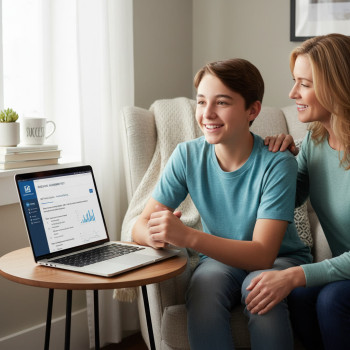Why the last week matters (but not how you think)
There’s a strange kind of pressure that settles in the final week before the SAT. Suddenly every practice problem feels like a referendum on your future, and every minute not spent with a pencil or keyboard feels wasted. That pressure is real — but it’s also the easiest thing to mismanage.
The last week isn’t a time to teach yourself whole new topics. It’s the time to sharpen what you already know, remove small friction points, and tune your body and mind so they perform smoothly on test day. Think of this week like the final tuning on a piano before a recital: small adjustments, lots of calm, and no frantic improvisation.
A clear mindset for the final seven days
Before we reach for study plans and checklists, set two intentions for the week:
- Confidence through clarity: Know exactly what you will do each day and why.
- Rest through preparation: Put systems in place that reduce stress so you can rest well without guilt.
Those two intentions will guide every choice — from what practice tests you take to when you put your phone away in the evening.
What to stop doing now
Every last-week plan should start by cutting out unhelpful habits. Here’s a short list of things that are counterproductive in the final seven days:
- Massive content cramming. If you’ve made it this far, you’ve learned the fundamentals. The week is for refinement, not overhauls.
- Taking more than one full timed practice test within 48 hours. Recovery matters — mental fatigue blunts performance and creates misleading score readouts.
- Switching tools or apps at the last minute. If you test on the Bluebook app, don’t begin using a new unfamiliar app now.
What to do instead: a prioritized checklist
Use this checklist as your north star. Do these things first; everything else is secondary.
- Device and logistics readiness: Install and practice with Bluebook (or the exact app you’ll use) on your test device, complete exam setup, and make sure your admission ticket and ID are in order.
- One realistic full-length practice test: Take one adaptive practice test no later than 3–5 days before test day, under test-like conditions. Use it to generate targeted practice, not as a performance verdict.
- Targeted practice blocks: Spend short, focused sessions on your top two weakest areas (no more than 45–60 minutes each) and then close the book.
- Active review of mistakes: Instead of redoing whole sections, revisit the logic on 10–20 selected missed questions from earlier practice tests and understand why wrong answers looked tempting.
- Timed question sets: Work through small timed sets (15–25 questions) to maintain pacing and timing strategies without causing exhaustion.
- Test-day simulation: Run through test-day logistics (device startup, calculator policy, breaks, snacks, travel time) once, so nothing is unknown on test morning.
Photo Idea : A calm study corner with a laptop open to a practice test, a notebook with strategy notes, and a glass of water—soft morning light.
Daily rhythm: how to structure each day in the final week
Consistency beats intensity here. Aim for two to three meaningful study sessions daily, with sleep and light movement prioritized. Below is a sample daily rhythm you can adapt to your schedule.
| Time | Activity | Why it helps |
|---|---|---|
| Morning (60–90 min) | Short practice set focusing on target skill (e.g., algebra problems or evidence-based reading passages) | Fresh brain for higher-order reasoning; reinforces skills without tiring you out |
| Midday (30–45 min) | Active review of mistakes from earlier practice tests | Converts mistakes into durable strategies; builds confidence |
| Afternoon/Evening (30–60 min) | Timed drills or a calm review session (vocab in context, grammar rules, calculator practice) | Maintains pacing skills and gives a gentle close to the study day |
| Night | Wind-down: no screens 30–60 mins before bed; light reading; sleep | Improves consolidation of learning and reaction times |
How to schedule practice tests (and why fewer is better)
A full-length adaptive practice test is the most informative single activity you can do — but it’s not a daily ritual. Here’s a sensible plan:
- Take one full-length adaptive practice test 3–5 days before test day. This gives you time to diagnose and fix small issues.
- If you want another practice test, take it at least 48–72 hours before test day and only if you can truly simulate test conditions.
- On the day directly before the test: no full practice tests. Do light review and logistics work only.
Why not more? Fatigue distorts your score and your sense of what to fix. A recovered, focused brain that next practices targeted weak spots trains more effectively than a tired brain pushing through another exam.
Targeted practice: how to choose what to focus on
Use your most recent practice test to identify the highest-leverage improvements you can make in a week. Usually, this narrows to two categories:
- Technique and timing: How do you approach long reading passages, or multi-step math problems? Can you shave 20–40 seconds off typical questions without losing accuracy?
- Recurring content gaps: Are there specific math topics or grammar rules that cause repeated mistakes? These are worth short, focused reviews.
Example: if your practice test shows that the majority of your errors in Math come from interpreting diagrams, schedule three 45-minute sessions over the week specifically practicing diagram interpretation and translating words into equations. Pair those sessions with time drills so you build both accuracy and speed.
Active review: the high-return way to learn from mistakes
Don’t just rework questions you missed — interrogate them. Use this short four-step process:
- Recreate the problem in your own words without looking at the solution.
- Explain why each wrong answer seemed plausible — what trap did it set?
- Write a one-sentence rule or strategy that prevents the mistake next time.
- Practice a different problem that tests that same skill within 24 hours.
This method turns a single missed question into a permanent improvement, rather than a one-night lament.
Timing strategies for the digital, adaptive SAT
The Digital SAT’s adaptive format means pacing and section strategy feel different than before. The goal is to keep a steady rhythm of accuracy and speed so the adaptive algorithm places you where you’ll perform your best.
- Use short timed sets (10–20 questions) to rehearse the rhythm of reading quickly and deciding when to mark a question and move on.
- Practice efficient marking: if a question will likely take more than half your average per-question time, flag and move on, then return if time remains.
- Trust educated guesses: there’s no penalty for wrong answers. Wild guesses are unnecessary, but smart elimination plus a guess is often the right call.
Test-day logistics: remove tiny unknowns
Logistics are the low-hanging fruit of stress reduction. In the week before, confirm these items so nothing surprises you on test day:
- Device readiness: Bluebook installed, tested, and exam setup completed. Charge your device and have a power plan (charger, battery bank, or spare fully charged device if allowed).
- Admission materials: ID and admission ticket saved in multiple places (printed and emailed to yourself). Pack them the night before.
- Travel plan: exact travel time, parking considerations, and buffer time for unexpected delays.
- Meals and breaks: plan non-messy, energy-sustaining snacks and a water bottle for between sections if allowed by your testing rules.
Photo Idea : A neatly packed test day bag laid out on a hallway bench: charger, ID, admission ticket printout, snacks, and a simple jacket.
How sleep, food, and movement affect your score
People often underestimate physiological factors. In the last week, small changes compound. Sleep consolidates memory; food fuels focus; movement keeps anxiety manageable.
- Aim for consistent sleep: same bedtime and wake time every day, with 7–9 hours of sleep.
- Prefer balanced meals: combine protein, complex carbs, and healthy fats before practice sessions to avoid energy crashes.
- Short aerobic breaks: 10–20 minutes of walking or light exercise improves alertness without draining you.
Using tools and tutors wisely in the last week
If you have access to a tutor or a personalized program, use it to get surgical help — not broad review. A good tutor in the final week does three things:
- Helps you interpret your most recent practice test and converts errors into 1–3 concrete strategies.
- Runs short, simulated sections with live feedback to refine pacing and approach.
- Helps you assemble a calm test-day plan and mental routines.
For students using Sparkl’s personalized tutoring, this is prime time to lean into 1-on-1 guidance: an expert tutor can craft tailored study chunks, build a day-by-day plan, and use AI-driven insights to track small wins so you feel momentum instead of stress.
Mental strategies and anxiety management
Test anxiety often spikes in week’s end, but small mental habits keep it in check:
- Practice a quick pre-test routine: three slow breaths, read the first passage once, annotate quickly, and begin. Rehearse this routine during practice tests.
- Use micro-affirmations: replace “I can’t” sentences with neutral observations — “This is a tricky question; I’ll mark and return.”
- Visualize success briefly each evening: imagine entering the test center calmly, following your plan, and finishing each section methodically.
What to do the day before and the morning of the test
The day before: avoid heavy studying. Do a gentle review of formulas, grammar rules, and a handful of practice questions if it helps your confidence. Confirm logistics and pack your bag. Prioritize sleep.
Morning of the test: eat a familiar breakfast, do a 10–15 minute light warm-up (a few math questions or a short reading passage), and arrive early. Use arrival time to settle, not cram.
Quick-reference final-week timeline
Here’s a condensed timeline you can pin to your wall:
- 7 days out: Confirm device and Bluebook readiness; plan travel logistics; reduce heavy studying to targeted practice.
- 5 days out: Take one full-length adaptive practice test under realistic conditions.
- 4–3 days out: Active review of missed questions; targeted practice on top two weak skills; light timed drills.
- 2 days out: Short, focused sessions; run through test-day routine once; get a good night’s sleep.
- 1 day out: No full practice test; light review only; pack bag; sleep early.
- Test day: Warm-up, trust your preparation, and use your pacing strategy.
Sample one-week study plan (pick and adapt)
This plan assumes school obligations, so sessions are short and focused. Replace topics with your personal weak points.
| Day | Morning | Afternoon | Evening |
|---|---|---|---|
| 7 days out | Device check + exam setup (30 min) | Targeted math review: algebraic translations (45 min) | Active review: 10 missed questions from prior test (30 min) |
| 6 days out | Reading: 2 short passages timed (45 min) | Grammar drills: 20 questions (30 min) | Relaxed review: quick formula sheet and sleep prep (20 min) |
| 5 days out | Full adaptive practice test (timed) — morning | Rest and light walk; no studying | Review first-pass errors from practice test (45 min) |
| 4 days out | Targeted practice on top 2 weaknesses (60 min) | Timed problem sets (30 min) | Mental routine rehearsal + light reading (20 min) |
| 3 days out | Short practice set + speed drills (45 min) | Review flagged questions; strategy adjustments (30 min) | Pack bag and confirm logistics (15 min) |
| 2 days out | Brief warm-up + pacing drills (30 min) | Light review only (30 min) | Sleep routine, no screens 60 min before bed |
| 1 day out | Very light practice (20 min) — confidence-building | Confirm travel plan; rest and hydration | Early bedtime |
When to reach out for help
If, in the last week, you feel stuck in a persistent and unproductive cycle — repeating the same mistakes, losing sleep over small errors, or unable to prioritize — reach out to someone who can provide focused help. A short 1-on-1 session with an experienced tutor can convert anxiety into a handful of actionable changes: tailored strategies, a clear plan, and accountability. Sparkl’s personalized tutoring, for example, can offer AI-informed diagnostics and an expert tutor to refine your final-week plan if you want guided, efficient support.
Closing thoughts: do less, better
The last week before the Digital SAT is a lesson in restraint. It asks you to trade frantic quantity for intentional quality: fewer full tests, clearer priorities, and more attention to rest and logistics. If you practice intentionally — diagnosing mistakes, rehearsing timing, and preparing your device and travel plan — you’ll walk into test day with something priceless: calm confidence.
Make your final week a series of small, smart moves. That patience, measured and deliberate, often produces the best results.















No Comments
Leave a comment Cancel